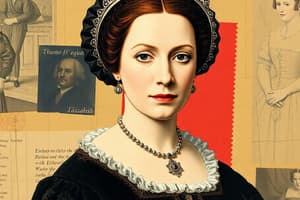Podcast
Questions and Answers
What was the name given to refusing to go to church?
What was the name given to refusing to go to church?
- Conformity
- Recusancy (correct)
- Renunciation
- Excommunication
What was the punishment for recusancy after 1559?
What was the punishment for recusancy after 1559?
- Fines of £5 per week
- 12d per week (correct)
- Community service
- Imprisonment for a month
What were Jesuit priests known for?
What were Jesuit priests known for?
- Training seminary priests
- Converting Catholics to Protestantism
- Converting Protestants to Catholicism (correct)
- Hunting Catholic priests
What was the aim of Elizabeth's policies towards Catholics?
What was the aim of Elizabeth's policies towards Catholics?
Why was Mary Queen of Scots considered a threat to Elizabeth?
Why was Mary Queen of Scots considered a threat to Elizabeth?
How successful was the Spanish Armada?
How successful was the Spanish Armada?
How did the Act of Persuasions make life harder for Catholics in 1581?
How did the Act of Persuasions make life harder for Catholics in 1581?
What was Elizabeth I's marriage situation by 1580?
What was Elizabeth I's marriage situation by 1580?
Who was in charge of England by 1580?
Who was in charge of England by 1580?
What was the religious situation in England by 1580?
What was the religious situation in England by 1580?
What is patronage in the context of Elizabeth's reign?
What is patronage in the context of Elizabeth's reign?
How did Elizabeth ensure no nobles became too powerful?
How did Elizabeth ensure no nobles became too powerful?
What was the name given to the queen's personal chamber?
What was the name given to the queen's personal chamber?
Which two Privy Councillors was Elizabeth most likely to listen to?
Which two Privy Councillors was Elizabeth most likely to listen to?
What name was given to Elizabeth's tours of England?
What name was given to Elizabeth's tours of England?
Flashcards are hidden until you start studying
Study Notes
Elizabeth's Control
- Elizabeth was unmarried in 1580 and unlikely to marry due to her advanced age.
- England was divided religiously between Catholics and Protestants by 1580.
- Elizabeth was in charge of England by 1580 but was advised by Parliament and other advisors.
- The Queen's household where nobles and gentry spent time was called the Court.
- The political nation in England was composed of the Queen, nobles, and gentry.
- Patronage was a system of gifts like money and land offered by the monarch.
- Elizabeth granted smaller amounts of patronage to many people to prevent powerful nobles.
- The Queen's personal chamber was called the Privy Chamber.
- Activities taking place in the Privy Chamber included gossip, reading, games, and playing with animals.
- The Privy Council was a group of men who advised Elizabeth on governing the country.
- The Privy Council provided guidance and advice to Elizabeth.
- Cecil and Walsingham were Elizabeth's most trusted Privy Councillors.
- The Earl of Essex's rebellion suggests that Elizabeth did not have full control of the Privy Council.
- Elizabeth controlled Parliament by placing Privy Councillors within it and banning certain topics from discussion.
- Privy Councillors and Puritans sometimes used Parliament to exert pressure on Elizabeth.
- Elizabeth and Parliament compromised on issues like monopolies.
- JPs (Justices of the Peace) and Lord Lieutenants were the two government officials who assisted Elizabeth in governing localities.
- Elizabeth's tours of England were known as Royal Progresses.
- Elizabeth controlled public perception by implementing Royal Progresses, restricting images, controlling the paintings permitted, and implementing censorship.
Religion under Elizabeth
- In 1558, England had several million Catholics and a few hundred thousand Protestants.
- Recusancy was the refusal to attend church.
- The penalty for recusancy after 1559 was 12d per week.
- The Elizabethan Settlement was Elizabeth's solution to the religious divide.
- By 1580, England had over a million Catholics and over a million Protestants.
- Church papists were Catholics who attended Protestant services.
- Conformers were Catholics who followed orders and became Protestants.
- Plotters were the Catholics who aimed to remove Elizabeth.
- Excommunication was the act of being removed from the Catholic Church.
- Seminaries were priest training schools.
- Jesuit priests were those who converted Protestants to Catholicism.
- A pursuivant was someone who hunted for Catholic priests.
- William Allen was significant during Elizabeth's reign because he trained seminary priests to support existing Catholics.
- Robert Persons and Edmund Campion were Jesuit priests seeking to convert Protestants.
- Priest hides were secret places used by Catholic families for hiding priests.
- Walsingham used spies to gather information about Catholics.
- The Act of Persuasions tightened the restrictions on Catholics in 1581, increasing the fines for recusancy to £20 a week.
- The Bloody Question and the Law Against Priests were used to identify and expose Catholics.
- Elizabeth's policies towards Catholics sought to strip them of status and wealth.
- Mary Queen of Scots posed a threat to Elizabeth because she was a Catholic figure who could rally support.
- Mary's threat grew after 1580 when the pope declared it permissible to kill Elizabeth.
- Mary Queen of Scots was ultimately executed for her involvement in the Babington Plot.
- Elizabeth provoked war with Spain in the 1580s by supporting Dutch Protestants.
- Philip II of Spain wanted to kill Elizabeth because she was a Protestant.
- The Spanish Armada was completely unsuccessful.
Studying That Suits You
Use AI to generate personalized quizzes and flashcards to suit your learning preferences.




